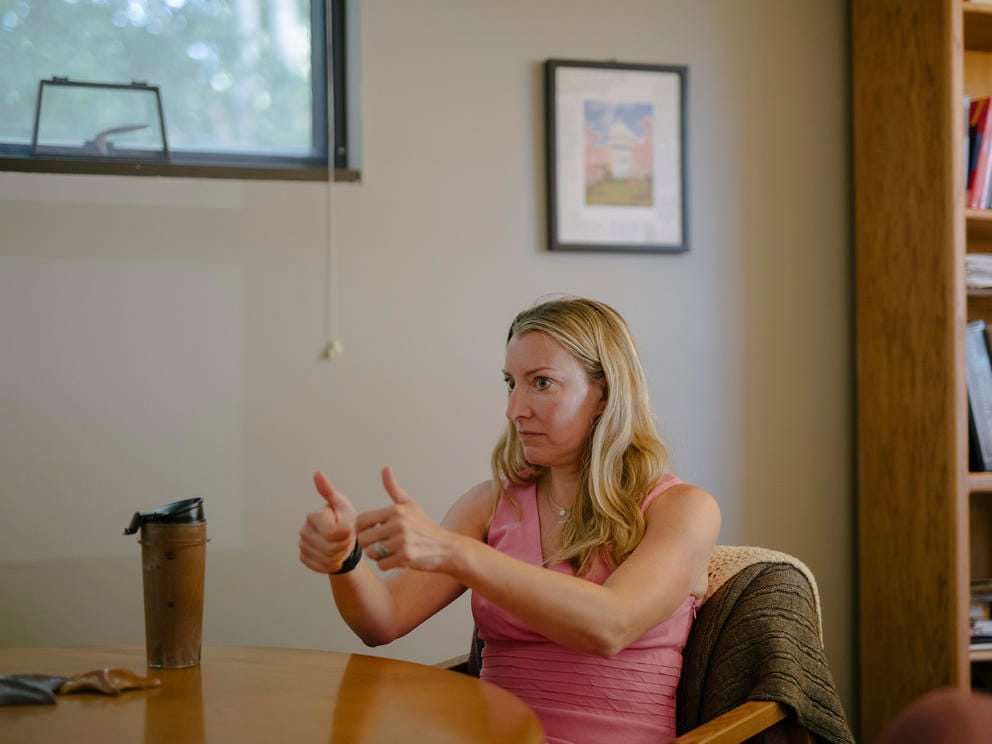Erika Lautenbach likes to joke that she has the worst job in Whatcom County.
As director of the Whatcom County Health Department, she is the face of the county’s coronavirus response, the go-to person on racial disparities in health care and the frontline leader of efforts to address homelessness, poverty and mental illness.
For her work fighting the COVID-19 pandemic, Lautenbach has been threatened by community members and castigated by elected officials. She and her staff are exhausted, mentally and physically. While logging 70-hour weeks to limit the number of hospitalizations and deaths, they have faced resistance from the very residents they are trying to protect, people fed misinformation by politicians that is reinforced on social media, all of which fuel a deep mistrust of government.
“I feel more like an elected official than I ever wanted to because I’ve become the target of all this public anger,” Lautenbach said. “It was just a hell storm, starting on day one.”
Across Washington state and around the nation, public health officials like Lautenbach are in crisis. Nationally, at least 248 public health leaders resigned, retired or were fired between April 1, 2020. and March 31, 2021, according to an ongoing investigation by The Associated Press and Kaiser Health News.
Experts call it the greatest exodus of public health leaders in American history. Those who remain are suffering mental health issues typically prevalent among war veterans and trauma survivors. A study by the Centers for Disease Control and Prevention of more than 26,000 public health workers found that more than half reported symptoms, including suicidal ideation, of conditions ranging from depression and anxiety to post traumatic stress disorder.
Public health budgets were slashed and slashed again in the decade before the pandemic. Understaffed county health departments were suddenly faced with their greatest challenge in generations. To make matters worse, the virus has been downplayed by political leaders and dismissed by those who have bought into their rhetoric.
The combination of pressures from above and below has created a meltdown among public health workers. Now the fallout is landing on the people they serve, those who are already the most vulnerable to disease, abuse and neglect.

Whatcom County Health Department Director Erika Lautenbach meets with Sue Sullivan, environmental health manager at the department, in Bellingham, Aug. 5, 2021. (Grant Hindsley for Crosscut)
Jaime Bodden, managing director of the Washington State Association of Local Public Health Officials, said the state has lost 18 health officers and administrators since the pandemic began. Health leaders have been fired or left their jobs in at least nine of Washington’s 39 counties — Grays Harbor, Lewis, Mason, Okanogan, Spokane, Walla Walla, Whatcom, Whitman and Yakima — as well as the Chelan-Douglas Health District.
Public health officials tend to stay in their jobs, building institutional knowledge and expertise that helps them navigate complex rules, regulations and financial systems, especially during crises. During a typical year, Bodden said the state loses one or two of them to retirement.
What’s more, the exodus is likely to continue because public pressures, governmental challenges and pandemic stress have not abated. Over the past year and a half, Bodden has seen vibrant, passionate public health leaders in Washington become overworked and disillusioned.
“A lot of my people are now vilified. They’ve had threats made against them,” Bodden said. “They don’t feel a part of their community and they don’t feel safe in their community and that’s a tough place to live.”
'You don’t realize how bad it is’
Lautenbach returned to Whatcom County in the winter of 2020, prepared to lead the department where she served as the assistant director from 2016 to 2018. She was scheduled to take over as health director March 25, 2020, but, as the pandemic took shape, she asked County Executive Satpal Sidhu if she could start a week early; her predecessor had left in early February and the department needed someone at the helm.
“There was a leadership vacuum,” Lautenbach said. “I knew we needed to move quickly; otherwise it was going to be a chasm rather than a gap.”
Lautenbach took charge of the department on March 18, the same day the U.S.-Canadian border closed to nonessential traffic and less than a week after both the northwestern Washington county and its largest city, Bellingham, declared public health emergencies. The next day, a man in his 60s became Whatcom County’s first confirmed COVID-19 death.
Lautenbach found herself in an uncommonly politicized environment within an intensely polarized national climate. The politically mixed Whatcom County Council also serves as the health board. None of the elected council members had a background in health, and they were all under pressure from constituents.
Three days after she started her job, Lautenbach was brought before the council and lambasted about the county’s coronavirus response.
“From an emotional and psychological perspective, it took a huge toll on me,” she said. “It’s the feeling of going through a divorce. You don’t realize how bad it is until it’s over and it’s part of your history.”
Lautenbach, who is not an elected official and has no plans to run for office, became the target of online tirades and Facebook firestorms. One night at 2:30 a.m. she received a phone message that was threatening enough for her to contact the police.
The initial vitriol about masking, business and school closures, and social distancing transformed this year into a reaction against anyone promoting vaccines, especially for younger residents.

A card from PeaceHealth Bellingham thanking the Whatcom County Health Department and other partners for their support during the COVID-19 pandemic sits on Erika Lautenbach’s desk at the Whatcom County Health Department in Bellingham, Aug. 5, 2021. (Grant Hindsley for Crosscut)
In July, a county council member critical of vaccines posted an email exchange on Facebook claiming Lautenbach’s department “has gotten too powerful and needs to be reined in.” The post, which has since been deleted, included a screenshot of an internal memo about funding for a program to promote COVID-19 vaccinations among 18- to 26-year-olds. The memo included Lautenbach’s cellphone number and direct email.
Lautenbach knew what would come next — a wave of angry emails claiming government overreach, accusations that she was running a “nanny state” and questions about the safety of vaccines. Her department received dozens of angry emails, one of which compared her to Hitler.
“It’s hard for me personally and professionally to be the recipient of misdirected anger and analogies like I’m Hitler and I’m trying to kill babies by pushing vaccine,” Lautenbach said. That weekend, she did something she never does: She turned off her cellphone and focused on her life outside of work.
The hardest time
Attacks similar to those Lautenbach experienced have been happening to public health workers across the country.
Lori Freeman, chief executive officer of the National Association of County and City Health Officials, has been tracking hundreds of threats against public health workers and the agencies they represent. Freeman said the threats start at the top with the harassment of Anthony Fauci, the director of the National Institute of Allergy and Infectious Diseases, his family and his children, and continue all the way down to the local level.
“It’s been the most challenging time for our health departments, not just because they’re trying to mitigate a terrible infectious disease and keep their communities safe, but because they’ve been targeted personally,” Freeman said.
While it’s easy to blame the anti-government vitriol on Donald Trump, and his rhetoric certainly added fuel to the fire, the former president merely tapped into a sentiment that was already on the rise, said Jeff Ketchel, executive director of the Washington State Public Health Association.
Ketchel said the growing resistance to public health actions dates back to a shift years ago from using educational approaches to fight chronic disease — like campaigns promoting healthy eating — to advocating for policy changes, like banning smoking in public parks. While officials see their actions as increasing public health, some in the community take new restrictions as evidence of a mounting assault on personal liberties.
“You set the stage for public health being an operative of the ‘nanny state,’ science being questionable and then, boom, let’s throw a pandemic on this society and let’s see what happens,” Ketchel said. “None of this is surprising for someone who’s worked for a while in public health.”
The backlash against public health measures during the pandemic has led state leaders elsewhere to enact new limits to the power of local health officials.
The Network for Public Health Law and the National Association of County & City Health Officials released a nationwide study in May that found 15 states had passed or were considering such measures, like a new law in Montana severely limiting public health actions that impact local businesses. In Washington state, Republican lawmakers proposed two bills that would have limited the power of health officials to impose restrictions during emergencies and given the state Legislature greater oversight power. Both bills failed.
Kathleen Hoke, a regional director with the Network for Public Health Law, said the pandemic has put public health workers in the spotlight, and public health efforts under a microscope.
“When we were anonymous, we wished people understood what we did,” said Hoke, who also heads the Legal Resource Center for Public Health Policy at the University of Maryland’s Carey School of Law. “Now everyone understands what we do and they’re all up in our business.”
But Hoke said all the attention could swing public opinion back in favor of public health workers. She pointed to a project at Johns Hopkins Bloomberg School of Public Health called, “We Stand With Public Health: A Call to Action,” which is working to expose and stop harassment of the public health workforce.
“We do think there are good stories to tell coming out of this as well,” Hoke said.
Hoke offered examples of state legislation, like a new law in Colorado to increase protection of public health workers from threats and political influence. In Washington, state lawmakers took steps this year to depoliticize public health in the wake of high-profile firing of a public health officer in Spokane and a failed attempt by members of the Pierce County Council to dissolve their health department. Legislation that goes into effect next summer requires that health care workers and community members — people who are not elected officials — hold at least half the seats on every health district board.
Vaccination efforts met with resistance
In addition to political pressures from above, many local public health leaders are facing resistance from their community and, in some cases, their own health board.
In Asotin County, on the southeastern edge of Washington, health district Administrator Brady Woodbury found that several doctors in town were speaking out against the COVID-19 vaccines and publishing editorials in local news outlets raising questions about vaccine safety.
As Woodbury was fighting that message with the help of pro-vaccine doctors, he also faced the challenge of conflicting messages from Lewiston, Idaho, the area’s largest city, across the Snake River from Asotin County. While schools were closed on his side of the river, they were open in Idaho, where masking was minimal and sports seasons were in full swing.

Erika Lautenbach fields four meetings and a Zoom call before lunch at the Whatcom County Health Department in Bellingham, Aug. 5, 2021. (Grant Hindsley for Crosscut)
“It’s almost like COVID didn’t happen there, but it did,” Woodbury said. “They have implications from that that we don’t have over here because of some of the measures we took.”
The inconsistencies didn’t sit well with parents in Clarkston, Asotin County’s largest city. They saw their kids miss sports seasons and wear masks, and then venture across the bridge to watch their friends in Lewiston do things they were prohibited from doing in Washington.
The uneven rules took a toll on businesses, too. Woodbury has a friend who owns a restaurant and who took the mask and social distancing rules seriously. He suffered financially as a result and lost business to other restaurants that weren’t enforcing the rules.
“We would go out and remind people, but we couldn’t shut them down,” Woodbury explained. “We’d have a riot if we tried to do that.”
‘Cumulative stress’
For the first six months of the pandemic, Wahkiakum County Health and Human Services Director Chris Bischoff didn’t have a day off. Every worker on his staff of 30 had to shift from the job they were trained to do to a new role — contact tracing and covid testing.
Bischoff had only one part-time public health nurse on his staff to investigate COVID-19 cases, which quickly became unsustainable. When the focus turned to vaccinating his 4,100 residents, his administrative staff became appointment bookers, chasing down locals for first and second doses.
As the head of public health for one of the smallest counties in the state, Bischoff manages a behavioral health clinic, as well as a bus system that transports residents to neighboring counties that have more services and job opportunities. When his staff’s attention turned exclusively to the pandemic, other areas suffered. At one point, every patient in the southwest Washington county’s substance use disorder program had relapsed.
Although he didn’t lose staff during 2020, Bischoff wonders how much more he can take. His plan was to work his entire life in public health. Now, he considers the 15 to 20 years he has until retirement and wonders if wants to put himself through that.
“A lot of it for me is the cumulative stress,” he said. “It can be fatiguing in the best of times, but it feels very overwhelming at this point.”
The pandemic’s harms have fallen hardest on the people public health departments most often serve, including communities of color. In Clark County, the Latinx community represents 10% of the population, but 25% to 30% of COVID cases, said Alan Melnick, the county’s public health director.
Last summer, 84 COVID cases were identified at a food-processing plant in Vancouver. Melnick said those workers and others who work in factories generally have less access to medical care, don’t have insurance, don’t get days off and have to work when they’re sick. They’ve also been less likely to get vaccinated.
“There’s not only been inequity in terms of impact, but there’s been inequity in terms of the vaccination results,” he said.

The Whatcom County Health Department, in Bellingham, Aug. 5, 2021. (Grant Hindsley for Crosscut)
In Whatcom County, Lautenbach and her staff are reaching out to migrant farmworkers, trying to get the word out about vaccinations and COVID testing. The health department helped open a weekly bilingual health clinic in Lynden through the summer. The mobile clinic can also travel to worksites, including the sprawling berry farms in the area. The department is creating informational materials not only in Spanish, but also in Indigenous Mesoamerican languages spoken by some migrant farmworkers.
In the Chelan-Douglas Health District, Administrator Luke Davies now conducts press conferences in English and Spanish. Davies estimated that Hispanics make up 30% of his district’s population, and have a higher vaccination rate than Anglos.
Davies took over in Chelan-Douglas in the middle of a political firestorm. His predecessor, Barry Kling, retired after three members of the Chelan-Douglas Board of Health joined a lawsuit aiming to overturn Gov. Jay Inslee’s emergency pandemic restrictions. When Davies took over in January, the district had been through two interim administrators and a COVID spike. Stress and politics had decimated the staff. Since the pandemic began, 20 workers — almost half the workforce — retired or quit.
But during that spike, board of health members visited a local hospital and witnessed the impact of the virus. Davies said the visit changed them.
“They’ve done a complete 180 from where they were last June,” said Davies, whose previous experience includes running a trauma center in Haiti after the 2010 earthquake. “If it wasn’t for having a supportive board, I probably would have thought about leaving by now.”
New enthusiasm for public health
Washington state lawmakers recently approved an unprecedented increase in state funding for public health.
“It took a pandemic to really get everybody’s attention,” said Ketchel of the Washington State Public Health Association. “I spoke with legislators and a lot of them were sheepish and apologetic about not giving more money sooner.”
The state Legislature dedicated an additional $147 million toward public health services over the next two years, an increase that would more than double during the 2023-2025 budget cycle.
Stephen Kutz, a member of the Cowlitz Tribe who chairs the American Indian Health Commission of Washington, said people tend to focus on public health only when emergencies pop up. He’s hopeful that the establishment of a well-funded system will change that, at least in Washington state.
“This opportunity to build together a more healthy robust public health system is one of the most important things we can work on right now,” Kutz said, “so we’re better resourced to take care of chronic diseases and also emergencies, whether it’s an earthquake or a pandemic, you name it.”
In Whatcom County, Lautenbach is forging ahead, encouraging family doctors to speak with their patients about vaccination and hosting pop-up clinics for the county’s most vulnerable populations. She realizes she will probably not convince the people who send her angry emails, but evidence suggests their doctors might have more luck. Meanwhile, Lautenbach and her staff are targeting those who face other obstacles, such as mobility issues, language barriers or fears about vaccine costs.
“We’re laser focused on people who have barriers to being vaccinated that don’t have questions about the efficacy or safety of the vaccine,” she said.

Erika Lautenbach at the Whatcom County Health Department, in Bellingham, Aug. 5, 2021. (Grant Hindsley for Crosscut)
Lautenbach worries the continued attacks on public health officials will push recent graduates away from the field, and lead current workers to make career changes. The week after the Facebook post that included her cell number and the influx of angry messages that followed, Lautenbach organized a department meeting to discuss the impact misinformation has on her staff — on their work, on their profession, on their families, on their friends and their own psyches.
“I don’t want my staff to feel like they might be targeted,” Lautenbach said, “and I want them to know I have their back.”
To combat the emotional toll of the pandemic, Lautenbach has started seeing a psychologist and started meditating. What gets to her most is not the anger or blame, but the fact that people are still dying when vaccines are available that could save them.
“There are disingenuous and cynical people who are swaying people to make choices in their lives that could kill them,” she said. “I don’t blame the people; I blame the leaders who are feeding them lies and disinformation.”



